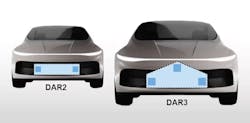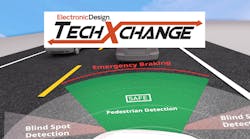Distributed High-Resolution Radar Elevates ADAS Performance
What you’ll learn:
- Radar is a cost-effective and dependable automotive sensor solution, even in challenging conditions such as fog, darkness, and rain.
- How size and cost are significant constraints on radar resolution and accuracy.
- NXP’s and Zendar’s joint effort to develop DAR technology, which uses small, low-cost sensors configured in a modular system.
High-resolution sensing is essential to navigating obstacles on the road. To accomplish this, drivers expect their vehicles to offer top-tier performance from advanced driver-assistance systems (ADAS). Radar and vision sensor technologies provide the necessary perception capabilities to enable these use cases.
Radar stands out as a cost-effective solution, even in challenging conditions such as fog, darkness, and rain. The main limiting factor of automotive radar performance, though, is aperture — the size of a radar's antenna array. Extracting more information from radar would allow ADAS systems to significantly enhance the overall performance and experience compared to current deployed solutions.
The size of a radar system is directly related to its performance. Larger radars have larger apertures, resulting in higher resolution. This poses a challenge given mounting constraints and the growing number of digital components. Traditionally, enlarging radar aperture has increased cost and power consumption.
What is DAR?
Distributed aperture radar (DAR) offers an alternative, enabling large virtual apertures using small, low-cost sensors configured in a modular system. With DAR, multiple small radar sensors can work together as a coherent system, forming a large virtual aperture (Fig. 1). DAR's coherent sensor fusion removes hardware constraints on aperture size, achieving excellent angular resolution with significantly lower power consumption than a single large sensor.
It's also notable that combining the data of multiple radars with an overlapping field of view makes it possible to perceive a traffic scene from multiple angles to increase detection accuracy. Thus, it reduces false positive and false negative detections and adds to the safety of the ADAS function. OEMs further benefit from a simplified system solution.
DAR has the potential to accelerate ADAS development and make autonomous driving more accessible. It fulfills the OEM objectives of advancing the radar architecture through early fusion of several radar sensors. This significantly enhances the performance while offering a clear separation between camera and radar perception.
>>Check out this TechXchange for similar articles and videos
Joint Effort Raises the Bar for High-Res Radar
NXP and Zendar joined forces to develop DAR technology, enhancing high-resolution radar systems for automotive applications. Leveraging NXP's S32R radar processor platform and RFCMOS SAF8xxx one-chip SoCs, the combined effort caters to the diverse architectures of car OEMs. Zendar's DAR software is designed to run on radar processors such as NXP’s S32R-based PurpleBox radar processor reference design, delivering a scalable and efficient solution for distributed radar systems.
With the shift toward software-defined vehicles (SDVs), automakers need an easier way to maintain and update their software to extract the untapped performance of the latest radar sensors. To evaluate a distributed radar architecture, NXP’s Pluto radar sensor, together with its PurpleBox, can be used.
PurpleBox is a reference design for distributed radar sensor architectures (Fig. 2). It’s designed to aggregate and process four-corner radar sensors at once, receiving compressed Range FFT data and producing a high-density surround point cloud.
PurpleBox comes with a comprehensive software development environment as well as a PCIe interface that can be used to attach a mass storage device or a machine-learning accelerator. This design offers an AI extension using a 26-TOPS machine-learning accelerator from Hailo, which unlocks new dimensions in the way radar data could be leveraged.
With the Pluto radar reference design, customers are able to evaluate corner and front radar applications. This reference design embeds an SAF8544 radar one-chip SoC, TJA1120B 1000Base-T1 Ethernet transceiver, an optimized FS56 system basis chip, and PF51 power-management IC in a small sensor form factor. Four transmitters and four receivers are paired with a patch antenna.
The reference design accelerates time-to-market and offers a validated system solution. The PurpleBox is available for NXP’s select customers with an approved NDA.
Fusing Sensor Data with the Automotive Radar Bridge
Also part of the DAR architecture is an automotive radar bridge, which is a dedicated processor designed to manage and fuse data from multiple radar sensors in a vehicle. Radar bridges can process and fuse radar sensor data in a zonal or central computer platform, which can be further fused with the vision perception data.
Such radar bridges enhance object detection accuracy, reduce false positives and negatives, and minimize latency in safety-critical ADAS functions by centralizing data processing from sensors with overlapping fields of view. In this way, it creates a more maintainable system, because it allows for over-the-air updates in the radar bridge instead of updating each sensor individually. A radar bridge can be co-located with the vision processor in the central ECU or with the zonal controller in the zonal ECU.
The platform allows for the incorporation of state-of-the-art algorithms for advanced angle finding and makes localization possible, which in the view of NXP currently isn’t implementable on edge radar systems due to limited processing capabilities of such systems. AL/ML could be leveraged to significantly enhance the radar output in addition to improving early sensor fusion and better sensor resolution.



